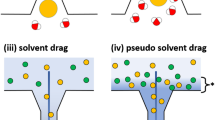Summary
Urea and water transport across the toad bladder can be separately activated by low concentrations of vasopressin or 8 Br-cAMP. Employing this method of selective activation, we have determined the reflection coefficient (σ) of urea and other small molecules under circumstances in which the bladder was transporting urea or water. An osmotic method for the determination of σ was used, in which the ability of a given solute to retard water efflux from the bladder was compared to that of raffinose (σ=1.0) or water (σ=0). When urea transport was activated (low concentration of vasopressin), σ for urea and other solutes was low, (σurea,0.08–0.39;σacetamide, 0.55; σethylene glycol, 0.60). When water transport was activated (0.1mm 8 Br-cAMP) σurea approached 1.0 σurea also approached 1.0 at high vasopressin concentrations. In a separate series of studies, σurea was determined in the presence of 2×10−5 m KMnO4 in the luminal bathing medium. Under these conditions, when urea transport is selectively blocked, σurea rose from a value of 0.12 to 0.89. Thus, permanganate appears to “close” the urea transport channel. These findings indicate that the luminal membrane channels for water and solutes differ significantly in their dimensions. The solute channels, limited in number, have relatively large radii. They carry a small fraction (approximately 10%) of total water flow. The water transport channels, on the other hand, have small radii, approximately the size of a water molecule, and exclude solutes as small as urea.
Similar content being viewed by others
References
Bentley, P.J. 1958. The effects of neurohypophyseal extracts on water transfer across the wall of the isolated urinary bladder of the toadBufo marinus.J. Endocrinol. 17:201
Carvounis, C.P., Franki, N., Levine, S.D., Hays, R.M. 1979. Membrane pathways for water and solutes in the toad bladder: I. Independent activation of water and urea transport.J. Membrane Biol. 49:253
Chevalier, J., Bourguet, J., Hugon, J.S. 1974. Membrane associated particles: Distribution in frog urinary bladder epithelium at rest and after oxytocin treatment.Cell Tissue Res. 152:129
Finkelstein, A. 1976. Nature of the water permeability increase induced by antidiuretic hormone (ADH) in toad urinary bladder and related tissues.J. Gen. Physiol. 68:137
Franki, N., Einhorn, R., Hays, R.M. 1975. Selective inhibition of urea transport by oxidizing agents. Evidence for a site of inhibition beyond the generation of cyclic AMP.J. Membrane Biol. 25:327
Harmanci, M.C., Kachadorian, W.A., Valtin, H., DiScala, V. 1978. Antidiuretic hormone-induced intramembranous alterations in mammalian collecting ducts.Am. J. Physiol. 235:F440
Hays, R.M., Harkness, S.H., Franki, N. 1970. The movement of urea and other small molecules across the toad bladder.In: Proceedings of the International Colloquy on Urea and the Kidney. B. Schmidt-Nielsen, editor. p. 149. Excerpta Medica, Amsterdam
Kachadorian, W.A., Levine, S.D., Wade, J.B., DiScala, V.A., Hays, R.M. 1977. Relationship of aggregated intramembranous particles to water permeability in vasopressintreated toad urinary bladder.J. Clin. Invest. 59:576
Kachadorian, W.A., Wade, J.B., DiScala, V.A. 1975. Vasopressin: Induced structural change in toad bladder luminal membrane.Science 190:67
Levine, S., Franki, N., Hays, R.M. 1973. A saturable, vasopressin-sensitive carrier for urea and acetamide in the toad bladder epithelial cell.J. Clin. Invest. 52:2083
Levine, S.D., Kachadorian, W.A., Schlondorff, D. 1979. Effect of hydrazine on vasopressin-stimulated water flow, particle aggregates and kinase activity in toad bladder.Clin. Res. 27:422A(abstr.)
Levine, S.D., Worthington, R.E. 1976. Amide transport channels across toad urinary bladder.J. Membrane Biol. 26:91
Masters, B.R., Yguerabide, J., Fanestil, D.D. 1978. Microviscosity of mucosal cellular membranes in toad urinary bladder: Relation to antidiuretic hormone action on water permeability.J. Membrane Biol. 40:179
Rosenberg, P.A., Finkelstein, A. 1978. Water permeability of gramicidin A-treated lipid bilayer membranes.J. Gen. Physiol. 72:341
Snedecor, G.W., Cochran, W.G. 1967. Statistical Methods. (6th Ed.) pp. 91–119. Iowa State University Press, Ames
Ussing, H.H. 1963. Effects of hypertonicity produced by urea on active transport and passive diffusion through the isolated frog skin.Acta Physiol. Scand. 59 (Suppl. 213):155
Ussing, H.H., Windhager, E. 1964. Nature of shunt path and active sodium transport path through frog skin epithelium.Acta Physiol. Scand. 61:484
Author information
Authors and Affiliations
Rights and permissions
About this article
Cite this article
Carvounis, C.P., Levine, S.D., Franki, N. et al. Membrane pathways for water and solutes in the toad bladder: II. Reflection coefficients of the water and solute channels. J. Membrain Biol. 49, 269–281 (1979). https://doi.org/10.1007/BF01871122
Received:
Issue Date:
DOI: https://doi.org/10.1007/BF01871122




